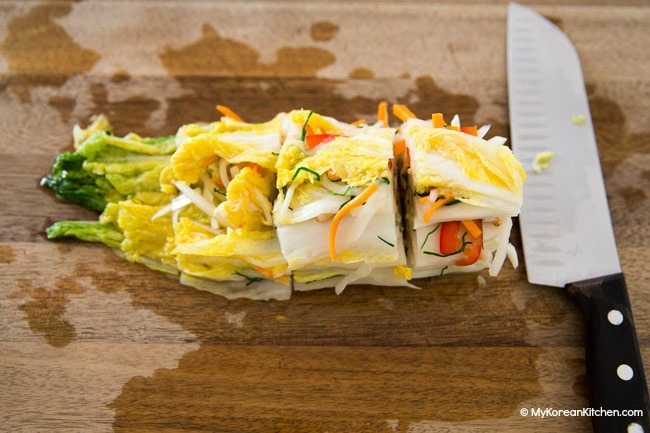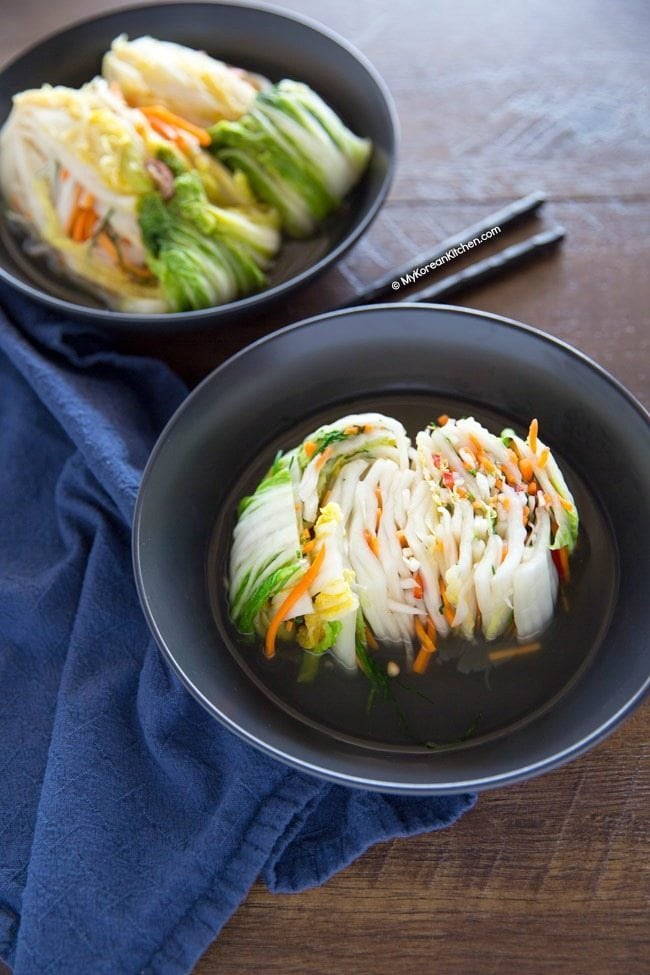I keep the solids and liquids together. When in doubt with ferments, the nose knows, so since you say it doesn't smell off, it'll be fine to eat. Sounds to me like you just got some oxidation on the portion of the surface with air contact, causing discoloration. I fight oxidation with my existing setup and I've got plans to transition to a better airlock for my ferments to minimize the possibility of it (and of naturally occurring organism contamination).Another question from the kimchi novice: after fermenting, the kimchi is covered with a dark brine - almost black. It smells OK, a bit funky but pretty much what other ferments I've done have smelled like. I tasted a piece and it tasted OK, too.
My question: Do you generally keep the brine and reincorporate it into the kimchi or pour it off after the fermentation is over? Thanks!
You are using an out of date browser. It may not display this or other websites correctly.
You should upgrade or use an alternative browser.
You should upgrade or use an alternative browser.
Anyone here make kimchi?
- Thread starter scrappy
- Start date

Help Support Kitchen Knife Forums:
This site may earn a commission from merchant affiliate
links, including eBay, Amazon, and others.
MowgFace
Senior Member
I would be concerned with a Dark Brine, as i have never seen it but seeing your process might help narrow it down.
As others, whenever ive made kimchi, it starts out the vibrant red that you would expect. Ive used Kosher salt, Fish Sauce (Usually for garlic Chive Kimchi), Shrimp Paste, and Oysters.
Brine and Solids need to stay together, best if everything stays submerged IME.
As others, whenever ive made kimchi, it starts out the vibrant red that you would expect. Ive used Kosher salt, Fish Sauce (Usually for garlic Chive Kimchi), Shrimp Paste, and Oysters.
Brine and Solids need to stay together, best if everything stays submerged IME.
Just made my third batch. Wonder if you can take a pic of the dark brine if it happens again.
Btw, kimchi makers: what’s the point of keeping the cabbage whole (or quartered, rather than chopped up) during the ferment? Doesn’t seem like the chopping is too damaging to it, and then you just have to chop it up later, which is annoying. Maybe the ferment is slightly slower without chopping…. But idk there must be a real point.
Btw, kimchi makers: what’s the point of keeping the cabbage whole (or quartered, rather than chopped up) during the ferment? Doesn’t seem like the chopping is too damaging to it, and then you just have to chop it up later, which is annoying. Maybe the ferment is slightly slower without chopping…. But idk there must be a real point.
Last edited:
I went home at lunch and planned to take a picture of the dark brine, but since I put the jar in the fridge last night (without the spring pressing the cabbage down), the brine has distributed itself back throughout the jar. The kimchi now looks more or less normal, although maybe just a bit darker than I'm used to seeing.
I'm really on the fence about whether to keep this. Like I said, I ate a piece last night and have suffered no ill effects, but I also don't want to take a chance and make anyone sick.
I'm really on the fence about whether to keep this. Like I said, I ate a piece last night and have suffered no ill effects, but I also don't want to take a chance and make anyone sick.
I always cut mine, before the ferment, fwiw.Just made my third batch. Wonder if you can take a pic of the dark brine if it happens again.
Btw, kimchi makers: what’s the point of keeping the cabbage whole (or quartered, rather than chopped up) during the ferment? Doesn’t seem like the chopping is too damaging to it, and then you just have to chop it up later, which is annoying. But there must be a point
MowgFace
Senior Member
Just made my third batch. Wonder if you can take a pic of the dark brine if it happens again.
Btw, kimchi makers: what’s the point of keeping the cabbage whole (or quartered, rather than chopped up) during the ferment? Doesn’t seem like the chopping is too damaging to it, and then you just have to chop it up later, which is annoying. Maybe the ferment is slightly slower without chopping…. But idk there must be a real point.
All of my korean friends have always tried to tell me its about taste and texture, though everyone's explaination at that point starts to become very subjective.
What I have observed is cutting into quarters or halves just makes it so each time you serve the Kimchi you have all the expected parts of your cabbage head. The crunchy stemmy bits, the balanced 50/50 stem/leaves, and leafy bits. Every time i have pre chopped, the bottom of the jar ends up being all of the leafy parts and texturally the kimchi is not as good towards the end of the Jar.
Hey, that actually makes a lot of sense. Was thinking about chopping mine up more thoroughly on my next go around because it seems like a bit of a nuisance otherwise, but now I think I won’t.All of my korean friends have always tried to tell me its about taste and texture, though everyone's explaination at that point starts to become very subjective.
What I have observed is cutting into quarters or halves just makes it so each time you serve the Kimchi you have all the expected parts of your cabbage head. The crunchy stemmy bits, the balanced 50/50 stem/leaves, and leafy bits. Every time i have pre chopped, the bottom of the jar ends up being all of the leafy parts and texturally the kimchi is not as good towards the end of the Jar.
@ian Could it also have to do with an increase in surface area when chopped? Like you say it may have been a traditional way to slow fermentation or maybe even inhibit mould growth by allowing for easier "stacking" of the cabbage in urns before refrigeration was available?
These days you can just throw it in the fridge at any point and you'll slow all the microbial and enzymatic action greatly. Softening of the cabbage and overly acidic ferments can be avoided or at least slowed pretty easily with a fridge.
Just a guess though and I think @MowgFace is onto something.
These days you can just throw it in the fridge at any point and you'll slow all the microbial and enzymatic action greatly. Softening of the cabbage and overly acidic ferments can be avoided or at least slowed pretty easily with a fridge.
Just a guess though and I think @MowgFace is onto something.
9mmbhp
Founding Member
- Joined
- Feb 28, 2011
- Messages
- 185
- Reaction score
- 146
Aesthetics play a part.
This is baek kimchi (aka 'white' kimchi since there is no gochugaru) which is traditionally made as quartered heads of napa with filling spread between each leaf. The quarters are often wrapped with extra outer leaves and tied for easier handling. Bundles are then sliced into thirds or halves to show the layers when serving.


This is baek kimchi (aka 'white' kimchi since there is no gochugaru) which is traditionally made as quartered heads of napa with filling spread between each leaf. The quarters are often wrapped with extra outer leaves and tied for easier handling. Bundles are then sliced into thirds or halves to show the layers when serving.


Last edited:
Yes! Aesthetics make sense, as does the distribution of textures point. It also makes sense that it’d slow fermentation a bit. Didn’t seem to me that it’d have a huge effect, tho… hasn’t in my experience, but I’ve only done it a few times.
Another thing I’ve heard said: historically people would make lots of kimchi at once. In that case it’s a lot of work to cut it all up at the start. Better to ferment first, then cut as needed.
Another thing I’ve heard said: historically people would make lots of kimchi at once. In that case it’s a lot of work to cut it all up at the start. Better to ferment first, then cut as needed.
Just a follow-up on my first attempt at kimchi with dark brine: it turned out fine. I maybe went a bit heavy on garlic, but otherwise, it tastes good, looks good and no one who has tried it has had any ill effects. Next time I make it, I'll follow the same recipe exactly and see if it again produces that dark brine.
Thanks to all who weighed as I pondered this!
Thanks to all who weighed as I pondered this!



